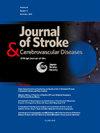Admission red blood cell distribution width as a prognostic biomarker of stroke-associated pneumonia and mortality in acute ischemic stroke patients treated with thrombolysis
IF 2
4区 医学
Q3 NEUROSCIENCES
Journal of Stroke & Cerebrovascular Diseases
Pub Date : 2025-01-31
DOI:10.1016/j.jstrokecerebrovasdis.2025.108254
引用次数: 0
Abstract
Background
Red blood cell distribution width (RDW) is an inflammatory marker potentially linked to stroke-associated pneumonia (SAP). This study assessed RDW's role in predicting SAP, mortality, and poor outcomes in acute ischemic stroke (AIS) patients treated with thrombolysis.
Methods
A retrospective analysis (2015–2022) of AIS patients treated with thrombolysis examined admission RDW levels. Outcomes included SAP, in-hospital (IHM) and 3-month mortality, and poor functional outcomes. Associations were analyzed using multivariable logistic regression, with predictive performance assessed via area under a receiver operating characteristic curve (AuROC), net reclassification index (NRI), and integrated discrimination improvement (IDI) metrics.
Results
Of 345 patients, 70 (20.3 %) developed SAP. A 1-SD increase in RDW was associated with SAP (adjusted odds ratio [aOR]: 1.73; 95 % CI: 1.27–2.35), IHM (aOR: 2.14; 95 % CI: 1.43–3.21), and 3-month mortality (aOR: 1.74; 95 % CI: 1.19–2.56). The association was stronger in non-diabetics and those under 65. Although RDW did not improve the AuROC for SAP or mortality predictions, it significantly improved the NRI and IDI (p < 0.05).
Conclusions
RDW is independently associated with increased risk of SAP, IHM, and 3-month mortality in AIS patients treated with thrombolysis, suggesting its potential as a prognostic marker.
求助全文
约1分钟内获得全文
求助全文
来源期刊

Journal of Stroke & Cerebrovascular Diseases
Medicine-Surgery
CiteScore
5.00
自引率
4.00%
发文量
583
审稿时长
62 days
期刊介绍:
The Journal of Stroke & Cerebrovascular Diseases publishes original papers on basic and clinical science related to the fields of stroke and cerebrovascular diseases. The Journal also features review articles, controversies, methods and technical notes, selected case reports and other original articles of special nature. Its editorial mission is to focus on prevention and repair of cerebrovascular disease. Clinical papers emphasize medical and surgical aspects of stroke, clinical trials and design, epidemiology, stroke care delivery systems and outcomes, imaging sciences and rehabilitation of stroke. The Journal will be of special interest to specialists involved in caring for patients with cerebrovascular disease, including neurologists, neurosurgeons and cardiologists.
 求助内容:
求助内容: 应助结果提醒方式:
应助结果提醒方式:


